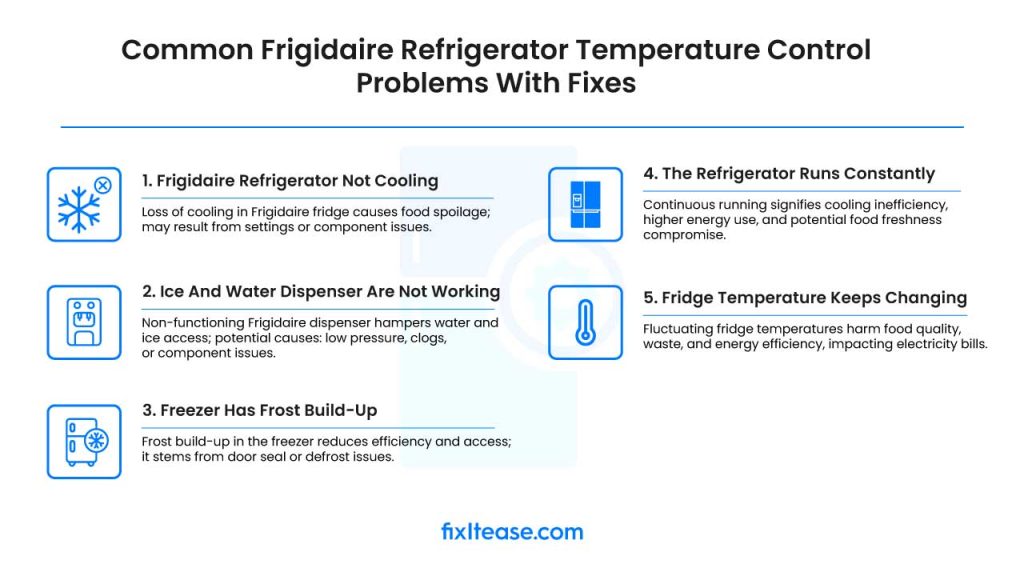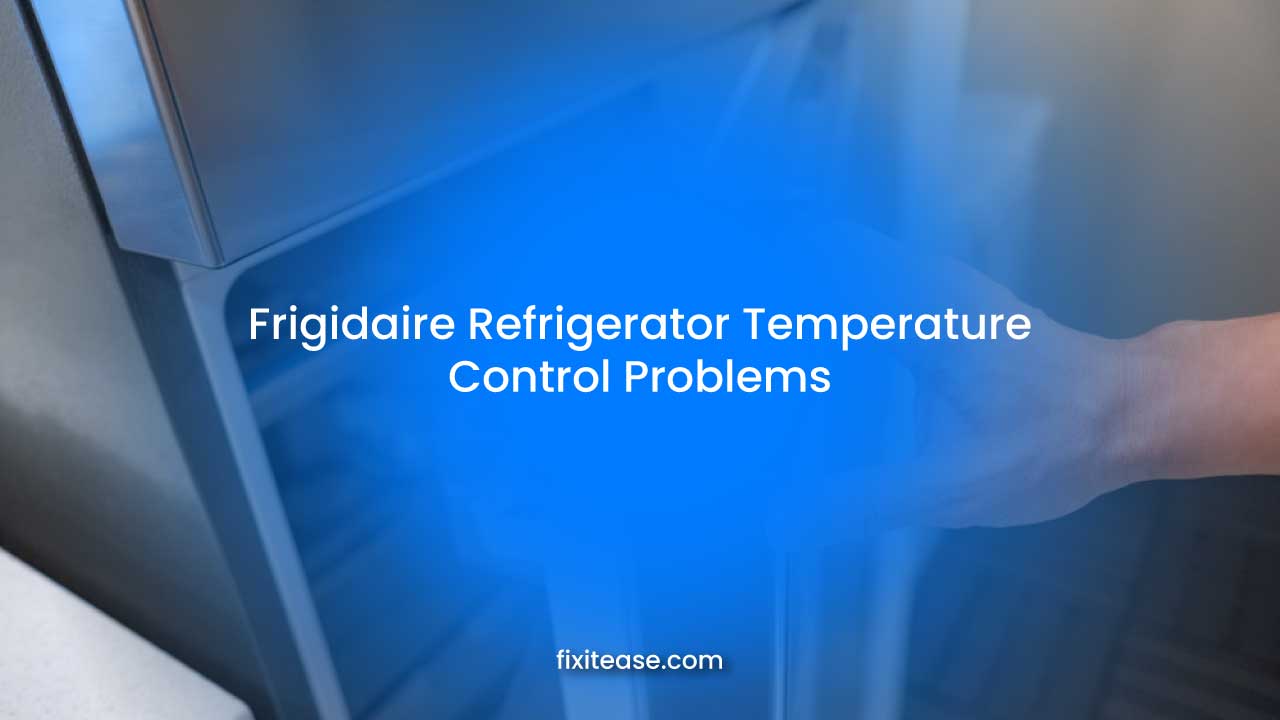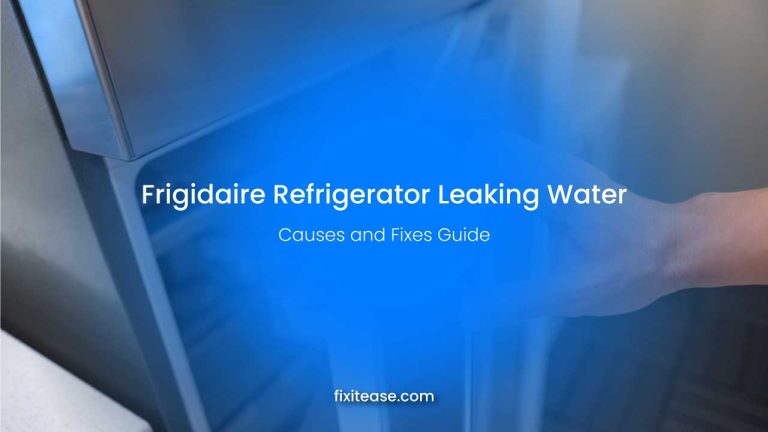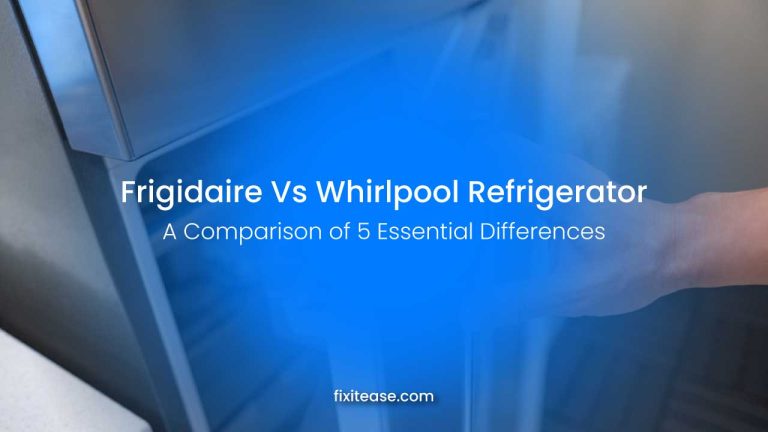Frigidaire Refrigerator Temperature Control? Step-by-Step Guide to Fixing
Temperature control problems can eventually damage a refrigerator and spoil the food inside it. But you don’t have to worry because a few ‘problem-solving techniques’ can solve the most common Frigidaire refrigerator temperature control problems. So, what are some common problems?
The refrigerator doesn’t cool is one of the most common issues related to the temperature control units of your refrigerator. Other issues can be a faulty ice and water dispenser, frost build-up in the freezer, temperature fluctuations, and a constantly running refrigerator.
However, not all of the problems require replacing the parts of your refrigerator, some issues require only a few know-how’s. We’re here to guide you right.
5 Common Frigidaire Refrigerator Temperature Control Problems With Fixes

Here we’ll discuss the most common temperature control problems Frigidaire refrigerator owners experience. Let’s see!
1. Frigidaire Refrigerator Not Cooling
When a Frigidaire refrigerator is not cooling, it means that the refrigerator is failing to maintain the proper low temperature required to keep your food cold and fresh.
This can lead to your food spoiling faster and poses a significant inconvenience. It can happen due to incorrect settings, power issues, or mechanical problems with components like the condenser, compressor, or cooling fan. Below are the details.
What Causes It
- Power Supply: Always ensure your refrigerator is plugged in and receiving power. A quick way to check is to see if the interior light turns on when you open the door. If not, verify the power source.
- Thermostat Malfunction: If the thermostat has been inadvertently turned off or is not working correctly, it can affect the cooling. Test it with a multimeter, and if it’s defective, it needs replacement.
- Blocked Vents: Check the vents located at the back of the freezer compartment. If they are obstructed by frozen items, like vegetables or ice cream boxes, it can hinder the circulation of cold air. Clear any blockages for proper cooling.
- Clogged Evaporator Coils: Vacuum the evaporator coils located either under or behind the appliance. If these coils are clogged with dust and debris, it can impede the circulation of cold air. Regular cleaning is essential.
- Condenser Fan: Inspect the condenser fan for obstructions and ensure it spins freely. Clean the fan blades and manually spin the fan to check for any obstructions. A non-functional condenser fan can affect cooling.
How to Fix It
- Adjust Refrigerator Temperature: If the temperature settings are incorrect, reset them to the recommended levels, typically between 35-37°F. Refer to your user manual for specific instructions on adjusting the settings for your refrigerator model.
- Make Space If The Refrigerator is Overloaded: Don’t overcrowd your refrigerator, or it can obstruct air vents and limit the airflow between items. Keep it around ¾ full to maintain optimal cooling and ensure air circulation.
- Compressor Replacement: If you suspect the compressor is the culprit, you can test it for continuity. If there’s no continuity, it’s likely dead and needs replacement. Unscrew the compressor and install a compatible replacement to restore cooling functionality.
2. Ice And Water Dispenser Are Not Working
When the ice and water dispenser in your Frigidaire refrigerator doesn’t work, you can’t access chilled water or ice from your fridge. The common reasons for it are low water pressure, a clogged water filter, a frozen water line, a defective water inlet valve, or problems with the ice maker assembly.
What Causes It and How to Fix:
- Clogged Water Filter: A clogged water filter restricts water flow and impacts both ice and water dispensing. To resolve this issue and enhance water quality, replace the filter every six months with a factory-authorized brand.
- Frozen Water Line: If the freezer temperature is set too low, it can cause the water line to the dispenser to freeze, leading to blockages. To thaw the frozen water line, disconnect the tube at the bottom of the door and attempt to blow air through it. Maintain the freezer temperature between 0-10 degrees Fahrenheit to prevent future freezing.
- Defective Water Inlet Valve: The water inlet valve supplies water to the dispenser. When it doesn’t receive sufficient water pressure or power, it restricts water flow. Check for continuity of power to the water inlet valve using a multimeter but it’s best to get it done by a qualified technician.
- Insufficient Water Pressure: The water inlet valve requires a minimum of 20 psi water pressure to function correctly. Ensure that the water pressure is sufficient and use a multimeter to test the water inlet valve for continuity. If it lacks continuity, replace the valve to solve the issue.
3. Freezer Has Frost Build-Up
When your freezer has frost build-up, it means that ice and frost are accumulating inside the freezer over time. This can lead to issues such as reduced cooling efficiency and difficulty accessing stored items.
The build-up typically occurs due to problems with the door seal, automatic defrost system malfunctions or other factors, and it needs to be addressed to maintain your freezer’s performance and prevent frost-related problems.
What Causes It
- Door Gasket Damage: A damaged door gasket that doesn’t create a proper seal can let warm, moist air into the freezer, leading to frost build-up.
- Automatic Defrost System Issues: Malfunctions in the automatic defrost system, including a failed defrost timer, electronic control board, or defrost sensor, can disrupt the defrost cycle which can result in excessive frost inside the freezer.
How to Fix It
- Check the Defrost System: To verify the proper functioning of the defrost system, opt for a manual defrost cycle. To do so, unplug the freezer and leave the door open for 24 hours.
If frost reappears within a few days after plugging in the freezer, you may have an issue with a defrost system component. Test each component using a multimeter for continuity and resistance. Replace any defective parts with compatible replacements.
- Inspect the Door Seal: Examine the door seal for damage such as cracks, tears, or gaps. Perform a dollar bill test by closing the door on a dollar bill and attempting to pull it out. If there is no resistance or you feel uneven sealing, replace the door seal with one that fits your model.
- Evaluate the Environment: Measure the relative humidity in your room with a hygrometer. Ideally, maintain a humidity level between 30% and 50% in the freezer’s environment.
If humidity is higher, use a dehumidifier, air conditioner, or fan to reduce it. Avoid placing the freezer near heat sources, direct sunlight, or moisture sources.
4. The Refrigerator Runs Constantly
When a refrigerator runs constantly, it means that it’s not cycling on and off as it should to maintain the desired temperature. This continuous operation causes a significant increase in energy consumption, leading to higher electricity bills. Furthermore, constant running can compromise the refrigerator’s cooling efficiency, which may affect the freshness of your stored food.
What Causes It
- Dirty Coils or Condenser: Dust and debris buildup on the coils or condenser at the back of the refrigerator can force it to run continuously. The heat from the motor gets trapped by the dust, making the appliance work harder.
- Power Interruptions: During power outages, your refrigerator may be affected, causing it to run continuously once the power is restored. To mitigate this, avoid frequently opening the refrigerator during outages.
- Hot or Warm Foods: Placing hot or warm foods inside the fridge makes it work harder to lower the temperature. This extra workload can lead to continuous running.
- Gasket Issues: The refrigerator’s gasket, which lines the outer edge of the door, may lose its sealing capability over time due to drying out, cracking, or breaking. This allows warm air to enter, prompting the appliance to run continuously. Replacing the gasket is the solution.
- Thermostat Settings: Incorrect thermostat settings, particularly in the freezer section, can result in prolonged operation. Adjust the settings as needed and allow time for temperature stabilization.
How to Fix It
- Clean Coils and Condenser: Periodically move your refrigerator away from the wall and vacuum the dust off the coils and condenser. Unplug the unit and remove the access panel behind the refrigerator at the bottom to access the coils.
Then, use a vacuum hose to remove dust and debris. Then, use a coil brush to clean any remaining dirt and dust clinging to the coils. Finally, replace the access panel. This maintenance helps your refrigerator operate efficiently.
- Minimize Power Interruptions: During power outages, it’s a must to keep the refrigerator closed as much as possible to retain the cold inside. Once power is restored, your Frigidaire may run continuously for up to four hours before reaching the right temperature.
- Pre-cool Foods: To reduce the workload on your refrigerator, allow hot or warm foods to cool on the countertop before placing them inside. Avoid leaving them out overnight, as this can promote bacterial growth.
- Replace Gasket: If you suspect the gasket is the issue, locate the small bolts holding it in place by lifting the bottom flaps. You can find replacement gaskets at home improvement stores or appliance outlets.
- Adjust Thermostat Settings: Check the thermostat settings for both the refrigerator and freezer sections. Ensure they are set appropriately for the room temperature. Be patient and allow up to 24 hours for the temperature to stabilize after making adjustments.
5. Fridge Temperature Keeps Changing
When a fridge temperature keeps changing, it means that the refrigerator is struggling to maintain a consistent and stable environment for your food. This inconsistency can have negative effects on the appliance.
It can lead to premature food spoilage, causing waste and potential health risks. The refrigerator’s energy efficiency can also be compromised which can result in higher electricity bills.
What Causes It
- Damaged Door Seal: If your refrigerator’s door seal is worn out or damaged, it may allow cold air to escape, which leads to temperature fluctuations.
- Frequent Door Openings: Each time you open the fridge door, cold air escapes, and the appliance works harder to cool down. This continuous loss of cold air can result in temperature fluctuations. Moreover, if the door remains open for an extended period, it can overcompensate by producing excessive cold air, which, when the door is closed, causes a rapid drop in temperature.
- Refrigerator Contents: Overcrowding or leaving the fridge underfilled can disrupt the even distribution of cold air. This can result in hot and cold spots, leading to temperature instability.
- Air Vents and Refrigerator Contents: Blocked vents and inadequate ventilation at the back of the refrigerator lower the appliance’s ability to maintain a uniform temperature. Proper airflow is essential for efficient cooling. Food items obstructing the airflow can cause localized temperature changes.
- Dirty Compressor Coils: The compressor coils are responsible for removing heat from the fridge. If they are dirty or clogged, heat cannot be efficiently dissipated, leading to poor temperature control. Cleaning the coils can restore proper heat exchange and stabilize the internal temperature.
How to Fix It
- Door Seal Issues: If the door seal is damaged, it’s essential to replace it. If it’s dirty or loose, clean it, and ensure it’s properly sealed. A proper door seal is needed to maintain a consistent temperature.
- Frequency of Door Openings: Limit the number of times you open the door and the duration it remains open. Being mindful of how often and for how long the door is open can help stabilize the temperature.
- Refrigerator Contents: Keep the fridge filled, but ensure there is adequate spacing for proper air circulation. Avoid overstocking the refrigerator to allow air to flow freely.
- Air Vents and Refrigerator Contents: Ensure the refrigerator has enough space at the back for proper ventilation. Verify that condenser coils, fans, and compressors are not obstructed. Proper airflow is vital for maintaining a consistent temperature.
- Dirty Compressor Coils: Clean the compressor coils to remove dirt and debris. To do this, pull the refrigerator away from the wall, vacuum the coils to clear any accumulated dirt, and wipe them down with a slightly damp cloth. After cleaning, monitor the fridge to see if the temperature stabilizes.
FAQs
How do you reset a Frigidaire refrigerator?
To reset a Frigidaire refrigerator, locate the control panel on the interior of the door. Press and hold the “Reset” or “Filter Reset” button for approximately 5 seconds until the indicator light turns off.
Release the button, and the refrigerator will reset to its default settings. For more specific resets or detailed instructions, consult the user manual or visit the manufacturer’s website for guidance.
Where Is The Control Panel On A Frigidaire Refrigerator?
The control panel on a Frigidaire refrigerator is typically located on the inside of the refrigerator’s door. There are different buttons and controls on this board for adjusting settings like temperature, ice, and water functions.
To access and operate the control panel, simply open the refrigerator door, and you’ll find it on the interior surface. Specific designs may vary, but it’s commonly situated in a visible and easily accessible position for user convenience.
What Is The Recommended Temperature For My Frigidaire Refrigerator?
The recommended temperature for a Frigidaire refrigerator is typically around 37 degrees Fahrenheit (2.8 degrees Celsius). This setting helps maintain food freshness and safety by preventing it from reaching temperatures where bacteria can thrive.
Additionally, if your Frigidaire refrigerator includes a freezer compartment, the freezer should be set at 0 degrees Fahrenheit (-17.8 degrees Celsius) to keep frozen items well-preserved. These settings are generally considered ideal for food storage and safety.
Last Words
In conclusion, addressing temperature control issues in your Frigidaire refrigerator will help you preserve your food’s freshness and safety.
We’ve discussed the most common issues, such as inconsistent temperatures and their causes, from a damaged door seal to blocked vents and dirty compressor coils. To maintain a stable temperature, you must identify these issues and follow the recommended fixes. Also, make sure you get professional help when needed.
Good luck!







